International Journal of Wireless and Microwave Technologies @ijwmt
Статьи журнала - International Journal of Wireless and Microwave Technologies
Все статьи: 574
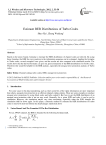
Estimate BER Distributions of Turbo Codes
Статья научная
Based on the union bound, formulas to estimate the BER distribution of channel codes are derived. By using these formulas, the BER for every position in the information sequence can be estimated. Appling the formulas to Turbo codes, several examples were given, and the results are also compared with simulation results. The results show that the derived formulas can give out good estimations of the BER distributions for Turbo codes. Therefore this would be helpful for the BER analysis, especially the unequal error protection analysis of Turbo codes.
Бесплатно
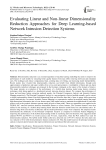
Статья научная
Dimensionality reduction is an essential ingredient of machine learning modelling that seeks to improve the performance of such models by extracting better quality features from data while removing irrelevant and redundant ones. The technique aids reduce computational load, avoiding data over-fitting, and increasing model interpretability. Recent studies have revealed that dimensionality reduction can benefit from labeled information, through joint approximation of predictors and target variables from a low-rank representation. A multiplicity of linear and non-linear dimensionality reduction techniques are proposed in the literature contingent on the nature of the domain of interest. This paper presents an evaluation of the performance of a hybrid deep learning model using feature extraction techniques while being applied to a benchmark network intrusion detection dataset. We compare the performance of linear and non-linear feature extraction methods namely, the Principal Component Analysis and Isometric Feature Mapping respectively. The Principal Component Analysis is a non-parametric classical method normally used to extract a smaller representative dataset from high-dimensional data and classifies data that is linear in nature while preserving spatial characteristics. In contrast, Isometric Feature Mapping is a representative method in manifold learning that maps high-dimensional information into a lower feature space while endeavouring to maintain the neighborhood for each data point as well as the geodesic distances present among all pairs of data points. These two approaches were applied to the CICIDS 2017 network intrusion detection benchmark dataset to extract features. The extracted features were then utilized in the training of a hybrid deep learning-based intrusion detection model based on convolutional and a bi-direction long short term memory architecture and the model performance results were compared. The empirical results demonstrated the dominance of the Principal Component Analysis as compared to Isometric Feature Mapping in improving the performance of the hybrid deep learning model in classifying network intrusions. The suggested model attained 96.97% and 96.81% in overall accuracy and F1-score, respectively, when the PCA method was used for dimensionality reduction. The hybrid model further achieved a detection rate of 97.91% whereas the false alarm rate was reduced to 0.012 with the discriminative features reduced to 48. Thus the model based on the principal component analysis extracted salient features that improved detection rate and reduced the false alarm rate.
Бесплатно
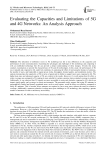
Evaluating the Capacities and Limitations of 5G and 4G Networks: An Analysis Approach
Статья научная
The utilization of millimeter waves in 5G technology has led to key differences in the capacities and performance of radio communications. Examining the advantages and challenges of this technology and comparing it with an established technology like 4G can provide a deeper understanding of these changes. Overall, this study conducts examinations to provide the characteristics of 5G and 4G technologies. In this study, the performance of 5G was evaluated and compared to 4G, under fair conditions, by analyzing the effect of increasing the distance of antennas, the number of users, and bandwidth on signal power, delay, throughput, channel quality, and modulation metrics. The analysis demonstrates the superiority of 5G in terms of speed and its ability to support more users compared to 4G. The higher data rates and enhanced capacity of 5G are evident in the results. However, it's worth noting that 4G offers a wider coverage area compared to 5G, making it more suitable for certain scenarios where extended coverage is essential. Additionally, it was observed that 5G signals are more susceptible to noise and obstacles compared to 4G, which can impact signal quality and coverage in certain environments. The presented results suggest that using 5G antennas in geographically limited and densely populated areas, such as rural regions, would be more cost-effective compared to using 4G antennas. This is because fewer antennas are required to serve more users without the need for extensive coverage. Additionally, numerous obstacles in urban areas pose challenges to 5G technology, thus requiring a greater number of antennas to achieve satisfactory accessibility.
Бесплатно
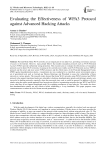
Evaluating the Effectiveness of WPA3 Protocol against Advanced Hacking Attacks
Статья научная
Personal Mode Home Wi-Fi networks are an integral part of our daily lives, providing convenience and ease of access to the Internet. However, many people believe that modern encryption protocols such as Wi-Fi Protected Access3 (WPA3) provide sufficiently strong protection. This research aims to evaluate the effectiveness of encryption protocols used in home Wi-Fi networks, focusing on the currently most widely used Wi-Fi Protected Access2 (WPA2) protocol and the newer and more secure WPA3 protocol, and the effectiveness of the Protected Management Frames (PMF) against deauthentication attacks. A penetration test was conducted in a controlled, secure environment using a set of specialized tools such as Aircrack-ng, Fluxion, Bettercap, and Wireshark to assess the vulnerability of these networks to various attacks. The research results showed that home Wi-Fi networks using WPA2 protocol and WPA3 protocol (who support transitional mode) are vulnerable to hacking. deauthentication attacks and dictionary attacks were successful in hacking networks, especially when the passwords were weak or could be guessed. In addition, evil twin attacks using the captive portal approach have been proven effective in penetrating networks that use WPA2 and WPA3 (even when they do not support transitional mode) by exploiting weaknesses in user behavior. The results also show that deauthentication attacks are still effective before establishing a 4-way handshake. This paper proposes some countermeasures to reduce the risk of home network penetration.
Бесплатно
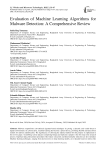
Evaluation of Machine Learning Algorithms for Malware Detection: A Comprehensive Review
Статья научная
Malware outperforms conventional signature-based techniques by posing a dynamic and varied threat to digital environments. In cybersecurity, machine learning has become a potent device, providing flexible and data-driven models for malware identification. The significance of choosing the optimal method for this purpose is emphasized in this review paper. Assembling various datasets comprising benign and malicious samples is the first step in the research process. Important data pretreatment procedures like feature extraction and dimensionality reduction are also included. Machine learning techniques, ranging from decision trees to deep learning models, are evaluated based on metrics like as accuracy, precision, recall, F1-score, and ROC-AUC, which determine how well they distinguish dangerous software from benign applications. A thorough examination of numerous studies shows that the Random Forest algorithm is the most effective in identifying malware. Because Random Forest can handle complex and dynamic malware so well, it performs very well in batch and real-time scenarios. It also performs exceptionally well in static and dynamic analysis circumstances. This study emphasizes how important machine learning is, and how Random Forest is the basis for creating robust malware detection. Its effectiveness, scalability, and adaptability make it a crucial tool for businesses and individuals looking to protect sensitive data and digital assets. In conclusion, by highlighting the value of machine learning and establishing Random Forest as the best-in-class method for malware detection, this review paper advances the subject of cybersecurity. Ethical and privacy concerns reinforce the necessity for responsible implementation and continuous research to tackle the changing malware landscape.
Бесплатно
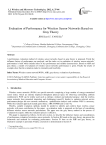
Evaluation of Performance for Wireless Sensor Networks Based on Gray Theory
Статья научная
A performance evaluation method of wireless sensor networks based on gray theory is proposed. Firstly the influence factors of performance are analyzed, and the index set in evaluation of wireless sensor networks' performance is built which include index of key performance and reliable characteristics. Based on AHP and gray theory, a model of evaluation of wireless sensor networks performance is given. Finally the results of example show that the evaluation model is rationality and feasibility.
Бесплатно
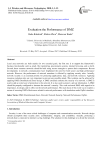
Evaluation the performance of DMZ
Статья научная
Local area networks are built mainly for two essential goals, the first one is to support the framework’s business functionality such as email, file transferring, procurement systems, internet browsing, and so forth. Second, these common networks should be built using secure strategies to protect their components. Recent developments in network communication have heightened the need for both secure and high performance network. However, the performance of network sometime is effected by applying security rules. Actually, network security is an essential priority for protecting applications, data, and network resources. Applying resources isolation rules are very important to prevent any possible attack. This isolation can be achieved by applying DMZ (Demilitarized Zone) design. A DMZ extremely enhance the security of a network. A DMZ is used to add an extra layer of protection to the network. It is also used to protect a private information. A DMZ should be properly configured to increase the network’s security. This work reviewed DMZ with regard to its importance, its design, and its effect on the network performance. The main focus of this work was to explore a means of assessing DMZ effectiveness related to network performance with simulation under OpNet simulator.
Бесплатно
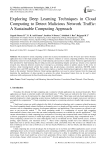
Статья научная
The demand for cloud computing systems has increased tremendously in the IT sector and various business applications due to their high computation and cost-effective solutions to various computing problems. This increased demand has raised several challenges such as load balancing and security in cloud systems. Numerous approaches have been presented for load balancing but providing security and maintaining integrity and privacy remains a less explored research area. Intrusion detection systems have emerged as a promising solution to predict attacks. In this work, we develop a deep learning-based scheme that contains data pre-processing, convolution operations, BiLSTM model, attention layer, and CRF modeling. The current study employs a machine learning-based approach to detect intrusions based on the attackers' historical behavior. Deep learning algorithms were used to extract features from the image and determine the significance of dense packets to generate the salient fine-grained feature that can be used to detect malicious traffic and presents the final classification using fused features.
Бесплатно
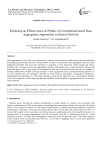
Статья научная
Data aggregation is one of the core processing in wireless sensor network which ensures that environmental data being captured reaches the user via base station. In order to ensure proper data aggregation, there are many underlying principles that need more attention as compared to more frequently visited routing and energy problems. We reviewed existing data aggregation schemes with special focus on data correlation scheme and found that there is still a large scope of investigation in this area. We find that there are only less number of research publications towards existing techniques of data aggregation using correlational-based approach. It was also explored that such techniques still does not focus much on data quality, computational complexity, inappropriate benchmarking, etc. This paper elaborates about all the unsolved issues which require dedicate focus of investigation towards enhancing the data reliability and data quality in aggregation process in wireless sensor network.
Бесплатно
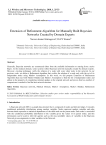
Extension of refinement algorithm for manually built Bayesian networks created by domain experts
Статья научная
Generally, Bayesian networks are constructed either from the available information or starting from a naïve Bayes. In the medical domain, some systems refine Bayesian network manually created by domain experts. However, existing techniques verify the relation of a node with every other node in the network. In our previous work, we define a Refinement algorithm that verifies the relation of a node only with the set of its independent nodes using Markov Assumption. In this work, we did propose Extension of Refinement Algorithm that uses both Markov Blanket and Markov Assumption to find the list of independent nodes and adhere to the property of considering minimal updates to the original network and proves that less number of comparisons is needed to find the best network structure.
Бесплатно
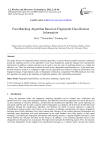
Fast Matching Algorithm Based on Fingerprint Classification Information
Статья научная
This paper focuses on fingerprint minutia matching algorithm. A special minutia neighbor structure is proposed during the matching process in this algorithm. It can locate fingerprints using the singular from classification information. In addition, minutia structure can be used to save the time of matching minutia in a simple but effective way. Then, the matching of minutia is based on the changeable sized boundary box. At the same time, possible reference position is computed to make sure the algorithm more robust to nonlinear deformation from fingerprint images. Experimental results on Fingerprint verification competition FVC2004 databases show that this algorithm can speed up the matching of fingerprint database with a preferable performance.
Бесплатно
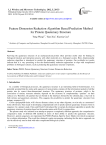
Feature Dimension Reduction Algorithm Based Prediction Method for Protein Quaternary Structure
Статья научная
Knowing the quaternary structure of an uncharacterized protein often provides useful clues for finding its biological function and interaction process with other molecules in a biological system. Here, dimensionality reduction algorithm is introduced to predict the quaternary structure of proteins. Our jackknife test results indicate that it is very promising to use the dimensionality reduction approaches to cope with complicated problems in biological systems, such as predicting the quaternary structure of proteins.
Бесплатно
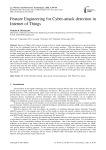
Feature Engineering for Cyber-attack detection in Internet of Things
Статья научная
Internet of Things (IoT) consists of group of devices which communicates information over private networks. One of the key challenges faced by IoT networks is the security breaches. With the objective of automating the detection of possible security breaches in five categories, IoT traffic created with Message Queue Telemetry Transport (MQTT) protocol is analyzed. The five categories of cyber-attacks considered are brute force, denial of service (DoS), flooding, malformed data, and SlowITe attacks along with legitimate traffic. The popular five machine learning (ML) models, LightGBM, Random Forest, MLP, AdaBoost, and Decision Tree Classifiers are trained to predict cyber-attacks. In traditional traffic analysis all the available features of MQTT traffic were utilized for the ML modeling and in this work, we challenge the practice by showing that automated feature selection improves the performance of the overall ML models. The average accuracy, precision, recall and the F1 score are used as performance evaluation metrics. It is observed that all models in average are able to achieve 90% of accuracy in classification, while MLP model is trained 10 times faster than the other models. Further the optimal number of features for correct classification is identified as 10 features through Monte Carlo analysis. With the reduced features, it is possible to detect DoS, flooding, and SlowITe attacks with more than 90% accuracy and precision. Yet, it is difficult to tell apart brute force and malformed data attacks.
Бесплатно
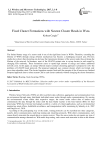
Fixed Cluster Formations with Nearest Cluster Heads in Wsns
Статья научная
The limited battery usage of a sensor node is one of the significant issues in WSNs. Therefore, extending the lifetime of WSNs through energy efficient mechanisms has become a challenging research area. Previous studies have shown that clustering can decrease the transmission distance of the sensor nodes thus, prolongs the lifetime of the network. In literature, most of the LEACH variants aim to set-up clusters in each round by changing CHs randomly. These formations cause to spend high amount of energy and induce additional network costs. In this paper, an energy-efficient nearest constant clustering approach is proposed to solve the problems of LEACH based protocols. The proposed approach uses constant clusters which are formed only once when algorithm starts. The cluster formation remains fixed until the energies of the all sensors are finished. Proposed approach aims to select nearest CHs in each cluster randomly without changing the cluster formations.
Бесплатно
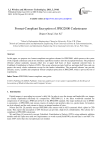
Format-Compliant Encryption of JPEG2000 Codestreams
Статья научная
In this paper, we propose two format-compliant encryption schemes for JPEG2000, which preserve the syntax of the original codestream and do not introduce superfluous markers into the encrypted bitstream. The proposed efficient scheme randomly encrypts either low or upper half bytes of those randomly selected bytes in Codeblock Contribution to Packets (CCPs). The secure scheme encrypts both low and upper half bytes and can protect the nearly whole codestream except for the header information. The proposed schemes can provide efficient, secure, scalable and completely format-compliant protection of JPEG2000, which is proved by lots of experiments.
Бесплатно
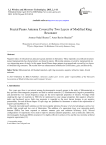
Fractal Peano Antenna Covered by Two Layers of Modified Ring Resonator
Статья научная
Negative index of refraction has attracted a great attention in literatures. These materials are artificial structures named metamaterials has characteristics not found in nature. Microstrip antennas covered by metamaterial are very interesting areas of study. In this paper fractal Peano shape antenna is proposed and covered by two layers of modified ring resonator. The results show an enhancement in Reflection Coefficients, gain, and directivity.
Бесплатно
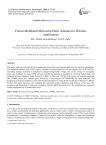
Fractal multiband microstrip patch antenna for wireless applications
Статья научная
This paper proposes a design of fractal multi-band microstrip patch antenna dedicated for wireless applications. The proposed antenna uses a FR-4 epoxy substrate having permittivity 4.4 and tangent loss to be 0.02.The microstrip antenna proposed is designed by incorporating double I-shape slot on the surface of rectangular patch and simulated by using HFSS software. Further the antenna is modified by inserting fractal shape and obtained the three frequency bands located at 2.4Ghz , 3.5Ghz and 5.50Ghz respectively and antenna parameter like VSWR, return loss, antenna gain, directivity of an antenna and bandwidth has been analyzed. The designing of proposed antenna is to be followed by fabrication by using A FR-4 substrate of thickness 1.60mm. Further, this paper discusses, the simulated and measured results comparison and analysis of the same. For designing and simulating of antennae simulation software HFSS has been used. The simulated and measured results represented are in permissible range.
Бесплатно

Frameproof Codes Based on The Generalized Difference Function Families
Статья научная
The frameproof codes are used in copyright protecting. Motivated by the method of constructing frameproof codes coined by D.Tonien etal, in this paper, we introduced a new combinatorial designs which in fact generalized the difference function family introduced by D.Tonien. The new designs can be constructed from difference matrix efficiently. By using the new designs we construct more larger number of frameproof codes .
Бесплатно

Статья научная
We are running in the communication era demanding a very large bandwidth for high speed applications. Among the available bandwidth technologies, the optical fiber seems the most appropriate and best fit. The optical fiber technology laid down at the backbone networks has almost replaced the preexisting coax cables. To extend fiber connectivity to the end user, especially in congested and remote areas is quite a difficult task in the context to cost and installation time. Therefore, the first and last mile connectivity (FLMC) is still a bottleneck in extending the beauty of optical fiber to the edge of the network. In most of the applications, the connectivity from backbone to the end user is carried out with the radio or copper links having a much lesser capacity than optical fiber. Keeping in view the nature and size of emerging applications, the FLMC needs to be addressed with the appropriate technology. To address this issue, the emerging solution is optical wireless communication like free space optics (FSO). The FSO is coming as a more promising alternative due to its properties like huge bandwidth and less cost. In this paper, we discuss the possible solution to first and last mile connectivity by FSO links and hence the gap between the optical core and the edge of network can be bridged by FSO communication in reliable and cost effective manner. The significance of the proposed work gives an everlasting impression of using FSO communication in FLMC over the existing ones. The ever increasing demand of high bandwidth can be meticulously met with the FSO communication. The simulation results show that the desirable performance is achieved and is analyzed with performance indicators like Q-factor and BER.
Бесплатно

Статья научная
This paper encompasses the numerical analysis involved with the Electromagnetic (EM) full-wave simulation tool Advanced Design System (ADS) which uses the Method of Moment (MOM) and Finite Element Method (FEM). MOM is utilized to solve Maxwell’s equations which are transformed into integral equations before discretization and boundary conditions are applied while FEM computes the electrical behavior of the high frequency EM wave distribution, and then analyze the antenna parameters. The main objective is to investigate the effect of reactive loading on the microstrip patch surface which is used to control the behavior of the impedance bandwidth and obtain dual-band frequency operation. The study further examines how the perturbed patch antenna design targets the operating frequencies of 2.4 GHz and 5.8 GHz for possible range and speed. The proposed method provides insight into the analysis of the mathematical model employed in attaining the Driving Point Impedance Function (DPF) of the E-patch microstrip patch antenna. This approach was done to quantify the reduction in reflections for improved Radio Frequency (RF) network output.
Бесплатно

